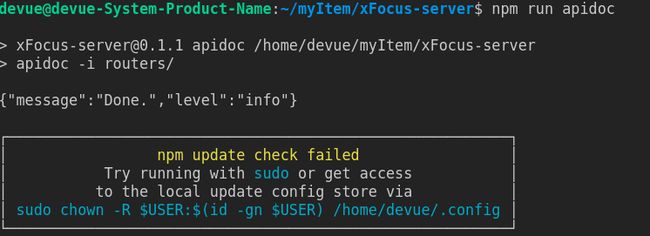效果
背景
之前做前端的时候,后端同学仗着自己是老同志,不给我接口文档
苦逼如我,需要拿着笔坐在他的旁边,听他口述
写下需要的api接口url和参数等等
现在自己做后端了,那不能这样子胡作非为了
自己吃的苦,怎能给其他同学吃呢?
这时候,apiDoc你值得拥有,稳稳的输出一篇优质的接口文档
安装apidoc
官网上是全局安装,我是喜欢安装到项目中,这样可以在另一个环境下,npm install就可以下载有所有依赖包
npm install apidoc --save-dev/-D
写注释
注册接口的注释
/**
* @api {post} /v1/auth/register User Register
* @apiName UserRegister
* @apiGroup userAuthentication
*
* @apiParam {String} username New user's username.
* @apiParam {String} password New user's password.
*
* @apiSuccess {String} username The username of the register user.
* @apiSuccess {string} message The registering success info.
*
* @apiSuccessExample Success-Response:
* HTTP/1.1 200 OK
* {
* "username": "username",
* "message": "User registered successful"
* }
*
* @apiError REGISTER_FAILURE The register failure.
*
* @apiErrorExample Error-Response:
* HTTP/1.1 500 Internal Server Error
* {
* "err": "REGISTER_FAILURE",
* "message": "User register failure!"
* }
*/
删除接口的注释
/**
* @api {delete} /v1/auth/user/ User delete
* @apiName UserDelete
* @apiGroup userAuthentication
*
* @apiParam {String} username User's username.
* @apiParam {String} executor Executor of this operation.
*
* @apiSuccess {String} username The username of the deleted user.
* @apiSuccess {string} message The message if deleting successful.
*
* @apiSuccessExample Success-Response:
* HTTP/1.1 200 OK
* {
* "username": "username",
* "message": "Delete User Successful"
* }
*
* @apiError NOT_LOGIN The register failure.
*
* @apiErrorExample Error-Response:
* HTTP/1.1 401 Unauthorized
* {
* "err": "NOT_LOGIN",
* "message": "User has not logon in!"
* }
*/
写入命令
将apidoc -i routers/写入package.json的命令中
routers文件夹下都是路由文件
"scripts": {
"test": "echo \"Error: no test specified\" && exit 1",
"lint": "eslint .",
"apidoc": "apidoc -i routers/",
"dev": "node --harmony index.js"
},
出现了{"message":"Done.","level":"info"},即成功了
执行命令
执行npm run apidoc即可拿到接口文档
这样,在项目中就会出现doc文件夹
生成文档
这样,doc文件夹中包含该页面的所有材料
打开index.html
热乎乎的接口文档诞生了
结构解读
一个静态的文档很漂亮的生成了,但是实际控制这个方法的是api_data.js和api_project.js。但是实际上的数据显示是由api_data.json和api_project.json这两个json文件。
所以在支持将其他json格式转换成api_data.json和api_project.json,把apidoc生成的这两个文件进行替换,然后替换js文件,直接生产静态文档。
命令行界面
查看所有命令
apidoc -h
选项|作用
--|--
-f --file-filters |用于选择应分析的文件的regex筛选器(可以使用多个-f)。(默认值:[])
-e, --exclude-filters |用于选择不应解析的文件/目录的regex筛选器(可以使用many-e)。(默认值:[])
-i, --input |输入/源目录名。(默认值:[])
-o, --output |输出目录。(默认:“./doc/”)
-t, --template |对输出文件使用模板。(默认值:“/usr/local/lib/node_modules/apidoc/template/”)
-c, --config |包含配置文件(apidoc.json)的目录路径。(默认值:“./”)
-p, --private|Include private APIs in output.
-v, --verbose|详细调试输出。
--debug|显示调试消息。
--color|关闭日志颜色。
--parse|只解析文件并返回数据,不创建文件。
--parse-filters |可选的用户定义筛选器。格式名=文件名(默认值:[])
--parse-languages |可选的用户定义语言。格式名=文件名(默认值:[]
--parse-parsers |可选的用户定义的分析器。格式名=文件名(默认值:[])
--parse-workers |可选的用户定义的工作人员。格式名=文件名(默认值:[])
--silent|关闭所有输出。
--simulate|执行但不写入任何文件。
--markdown [markdown]|关闭默认标记分析器或将文件设置为自定义分析器。(默认值:真)
--line-ending |关闭自动检测行尾。允许值:lf,cr,crlf。
--encoding |设置源代码的编码。[UTF8]格式。(默认值:“utf8”)
-h, --help|输出使用信息
所用的的apiDoc的参数(翻译)
@api
@api {method} path [title]
必需的!
如果没有该指示器,apidoc解析器将忽略文档块。
唯一的例外是@apidefine定义的文档块,它们不需要@api。
Usage: @api {get} /user/:id Users unique ID.
Name|Description
--|--
method|Request method name: DELETE, GET, POST, PUT, ...
path|Request Path.
title optional|A short title. (used for navigation and article header)
/**
* @api {get} /user/:id
*/
@apiName
@apiName name
应始终使用。
定义方法文档块的名称。名称将用于生成的输出中的子导航。结构定义不需要@apinname。
用法:@apinname getuser
Name|Description
--|--
name|方法的唯一名称。可以定义相同的名称和不同的@apiversion。格式:method+path(例如get+user),只有一个建议,您可以根据需要命名。也可以用作导航标题。
/**
* @api {get} /user/:id
* @apiName GetUser
*/
@apiGroup
@apiGroup name
应始终使用。
定义方法文档块所属的组。组将用于生成的输出中的主导航。结构定义不需要@apigroup。
用法:@apigroup user
Name|Description
--|--
name|组名称。也使用导航标题。
/**
* @api {get} /user/:id
* @apiGroup User
*/
@apiParam
@apiParam [(group)] [{type}] [field=defaultValue] [description]
描述传递给API方法的参数。
用法:@apiparam(mygroup)number id users unique id。
Name|Description
--|--
(group)optional|所有参数都将按此名称分组。如果没有组,则设置默认参数。您可以使用@apidefine设置标题和说明。
{type}optional|参数类型,如{Boolean}, {Number}, {String}, {Object}, {String[]}
{type{size}}optional|变量大小的信息{string{..5}} 最大值为5的字符串.{string{2..5}} 最小2最大为5的字符串.{number{100-999}} 在100到999的i数字.
{type=allowedValues}optional|有关变量允许值的信息。{string="small"}包含small的字符串,{string="small","huge"}包含small/huge的字符串,{number=1,2,3,99}一个允许值是1,2,3,和99的数字,{string {..5}="small","huge"}最多5个字符的字符串,只包含单词“small”或“mage”。
field|变量名称.
[field]|带括号的fieldname将变量定义为可选变量。
=defaultValueoptional|参数默认值。
descriptionoptional|字段的说明。
/**
* @api {get} /user/:id
* @apiParam {Number} id Users unique ID.
*/
/**
* @api {post} /user/
* @apiParam {String} [firstname] Optional Firstname of the User.
* @apiParam {String} lastname Mandatory Lastname.
* @apiParam {String} country="DE" Mandatory with default value "DE".
* @apiParam {Number} [age=18] Optional Age with default 18.
*
* @apiParam (Login) {String} pass Only logged in users can post this.
* In generated documentation a separate
* "Login" Block will be generated.
*/
@apiSuccess
@apiSuccess [(group)] [{type}] field [description]
成功返回参数。
用法:@apiSuccess {String} firstname Firstname of the User。
Name|Description
--|--
(group)optional|所有参数都将按此名称分组。
如果没有组,则设置默认成功200。
您可以使用@apidefine设置标题和说明。
{type}optional|返回类型,如{Boolean}, {Number}, {String}, {Object}, {String[]}
field|返回标识符(返回成功代码)。
description optional|字段的说明。
/**
* @api {get} /user/:id
* @apiSuccess {String} firstname Firstname of the User.
* @apiSuccess {String} lastname Lastname of the User.
*/
Example with (group), more group-examples at @apiSuccessTitle:
/**
* @api {get} /user/:id
* @apiSuccess (200) {String} firstname Firstname of the User.
* @apiSuccess (200) {String} lastname Lastname of the User.
*/
Example with Object:
/**
* @api {get} /user/:id
* @apiSuccess {Boolean} active Specify if the account is active.
* @apiSuccess {Object} profile User profile information.
* @apiSuccess {Number} profile.age Users age.
* @apiSuccess {String} profile.image Avatar-Image.
*/
Example with Array:
/**
* @api {get} /users
* @apiSuccess {Object[]} profiles List of user profiles.
* @apiSuccess {Number} profiles.age Users age.
* @apiSuccess {String} profiles.image Avatar-Image.
*/
@apiSuccessExample
@apiSuccessExample [{type}] [title]
example
成功返回消息的示例,输出为预先格式化的代码。
用途:` @apiSuccessExample {json} Success-Response:
{ "content": "This is an example content" }`
Name|Description
--|--
typeoptional|响应格式
titleoptional|示例的简短标题
example|详细示例,支持多行
/**
* @api {get} /user/:id
* @apiSuccessExample {json} Success-Response:
* HTTP/1.1 200 OK
* {
* "firstname": "John",
* "lastname": "Doe"
* }
*/
@apiError
@apiError [(group)] [{type}] field [description]
成功返回参数。
用法:@apiError UserNotFound。
Name|Description
--|--
(group)optional|所有参数都将按此名称分组。如果没有组,则设置默认错误4xx。您可以使用@apidefine设置标题和说明。
{type}optional|返回类型,如{Boolean}, {Number}, {String}, {Object}, {String[]}
field|返回标识符(返回失败代码)。
description optional|字段的说明。
/**
* @api {get} /user/:id
* @apiSuccess {String} firstname Firstname of the User.
* @apiSuccess {String} lastname Lastname of the User.
*/
@apiErrorExample
@apiErrorExample [{type}] [title]
example
失败返回消息的示例,输出为预先格式化的代码。
用途:` @apiErrorExample {json} Error-Response:
This is an example. `
Name|Description
--|--
typeoptional|响应格式
titleoptional|示例的简短标题
example|详细示例,支持多行
/**
* @api {get} /user/:id
* @apiErrorExample {json} Error-Response:
* HTTP/1.1 404 Not Found
* {
* "error": "UserNotFound"
* }
*/
参考文献
apidoc官网
接口文档神器之apidoc
apidoc快速生成在线文档,apidoc生成静态文件的生成规则,原理分析,实践
欢迎大家进群,参与讨论
一起进步,是我们的准则,我们是前端的一道美丽风景线
请加我的vx:qiufeihong0203,拉你进群
欢迎关注feihong的掘金账号。
原文地址。
版权声明
转载时请注明作者 qiufeihong 以及本文地址:http://www.qiufeihong.top/technical-summary/apiDoc/





